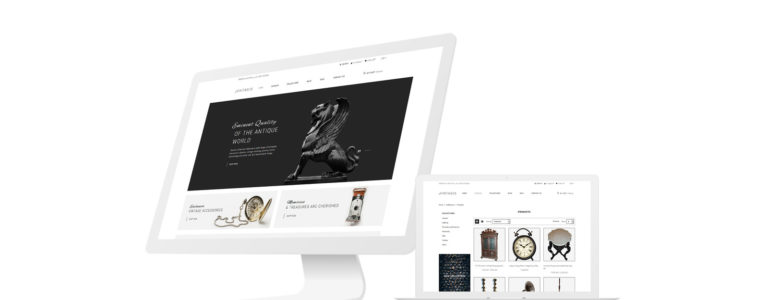Content ideas to add to an antique website
The best way to make your website user-friendly is to imagine the reasons why a potential customer comes to your site. Most often it is to browse your inventory and purchase antiques directly from your website, know the opening hours of your shop, find a way to contact you, or the direction to your store.
It is, therefore, necessary to make this information very visible and easily accessible. Customers may want to contact you for an appraisal, for example. Your phone number and a contact form should be accessible from the home page. Then come the list of your specialties, etc. You should organize your site by making the most frequently searched information easily accessible.
Your products: If the primary purpose of your site is to sell antiques, it is essential that your shopping area is easy to access. Maybe even directly located on the landing page of your site. It is necessary to save potential customers an endless product search because each unnecessary click means an increase in the probability of abandoning your website in favor of a competing merchant. In addition, it will be imperative to display optimized HD photos of the products, as well as their prices and an accurate description. Last but not least, pages should load quickly: 53% of mobile site visits are abandoned if pages take longer than 3 seconds to load. A 2-second delay in load time resulted in abandonment rates of up to 87%.
Your training, your studies, your background: Introduce yourself on your website, and tell the story of how you came to open an antique business. Describe your training, your internships, your different jobs. This way of introducing yourself will make your activity more personal and will inspire confidence.
Free or paid expertise of objects: Offering free appraisals provides access to potential sellers. When tidying up an attic or settling an estate, treasures can be discovered. Inform your site visitors about the possibility of obtaining free or paid expertise, depending on your preference.
Tips and tricks for restoring an object: Even if you don’t do furniture or object restoration, you know techniques for restoring or taking care of antiques. If for instance, you know of a very good product to clean or restore furniture, or on the contrary, a very bad product, do not hesitate to speak about it. You will add content to your antique site that will make it even more interesting. By creating a section with tips and tricks in this field, you will help Internet users and you will make your antique site more attractive than a simple store site. It is also great for SEO and to help your site rank at the top of search engine result pages!
Shipping service for antiques purchased: Contact a carrier near your business to find out about the conditions and rates for shipping bulky items and furniture. You will then be able to display on your site the possibility of shipping the purchased items.
Display your most exceptional items online: Display and document the most beautiful and amazing objects and furniture on your site. Even if some items are already sold, these documentation pages will illustrate and enhance your site.
House clearance: It can be interesting to offer a service like a house clearance or estate sale. This service can be free or paid depending on the items to be cleared. If the house contains a lot of objects and furniture that can be resold, the service can be free. On the other hand, if a cellar full of garbage has to be emptied, the service may be charged. The distance to the place to be cleared can also affect the price. You can describe all these elements on a specific page of your website.
Advertise your specialties and time periods on your home page: In order to properly inform your site’s visitors, it is a good idea to highlight your preferred historical periods or the objects you particularly want to buy or sell. You can illustrate this information with photos or drawings.
Inform your visitors about upcoming antique fairs and shows: Add a calendar to your website to inform your visitors about all the antique-related events that may interest them. Indicate the dates of antique shows, fairs, yard sales, auctions, exhibitions, etc…
Offer a credit solution: In order to help your customers finance important purchases such as a large quantity of furniture, you should contact credit agencies and choose the one that seems to be the most reliable, the easiest to use and the least expensive. You will then be able to offer a credit on your website and in your store if needed.
Excellent photographic quality for the art objects for sale: You should take special care of the quality of the photos that will be displayed on your site. The sharpness should be excellent in order for visitors to see all the details of the object. The background should be neat. Ideally, the photos should be taken on a neutral background and with a white light in order not to distort the colors.
Share your passion and your discoveries on social networks: In addition to an e-commerce website, it is also advised to strengthen your online presence by creating a page on Facebook and/or Instagram. You will be able to quickly publish information or pictures about your antique business on these social networks. It could be for example the picture of the item you just added to your inventory, and which is particularly interesting. You can also share a tip on how to fix a particular material or advertise a flea market in your area.
Think of the collectors: To sell your merchandise, look for the collector. Whatever the object, there is a collector in the world potentially interested in it, and collecting that object has a name. Think of grouping in your store similar objects that could interest a collector, take pictures and publish this picture on your site to attract suitable collectors and thus be able to sell these objects. Remember to put some text under the picture as search engines detect texts and not only pictures.
Highlight your specialties, your preferred historical period: An antique dealer or a second-hand dealer is sometimes more specialized in certain eras, in certain furniture or in certain objects. This may be due to the region in which the store is located, a personal taste, or a request from customers. Highlight this specialty on your website by creating pages of information, and photos to attract collectors or customers looking for this type of object.
Test furniture care products: A website also allows you to express yourself and to inform. If you discover a very good product to clean or restore furniture, or on the contrary, a very bad product, do not hesitate to speak about it. You will add content to your antique site that will make it even more interesting.
Offer art books and historical books: Add to your site a literature category in which you recommend books to increase one’s artistic culture. This way, your antique site will become a real portal dedicated to antique objects and not only an antique dealer site. You can also join an affiliate program on Amazon and get a percentage on each sale made from your site.
Offer training in the maintenance or restoration of antiques: There may be enthusiasts around you who might be interested in training in the restoration of antique objects or furniture. You could design a training program with topics that may be popular, such as cleaning and embellishing waxed furniture, or restoring porcelain, etc. These half-day or full-day training can be done during the slow days of your store’s operation and provide an additional income.
Open a discussion forum dedicated to second-hand goods: By adding a forum to your site, you will allow your visitors to discuss everything related to antiques and secondhand goods, and to exchange tips and advice in this field.
Rent antiques: On a page of your site, inform visitors that it is possible to rent an object or a piece of furniture available in the store. This way you can open up the market to film or commercial makers, photographers, or anyone who wants to temporarily decorate a place.



